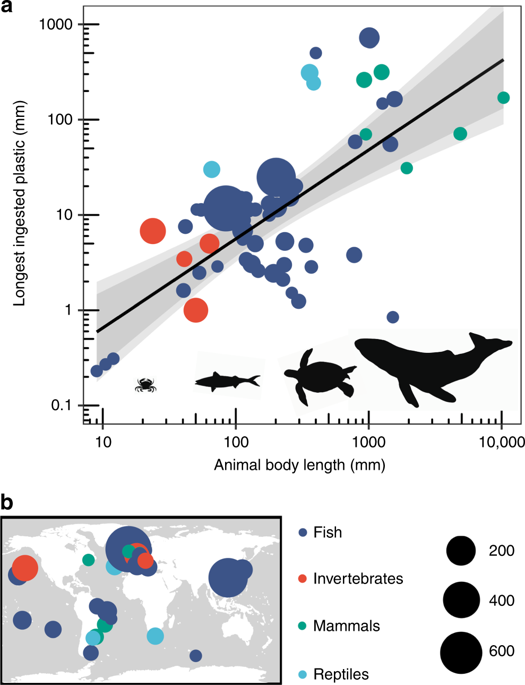Nature Communications ( IF 14.7 ) Pub Date : 2020-03-27 , DOI: 10.1038/s41467-020-15406-6 Ifan B Jâms 1 , Fredric M Windsor 1 , Thomas Poudevigne-Durance 2 , Steve J Ormerod 1 , Isabelle Durance 1

|
The ingestion of plastics appears to be widespread throughout the animal kingdom with risks to individuals, ecosystems and human health. Despite growing information on the location, abundance and size distribution of plastics in the environment, it cannot be assumed that any given animal will ingest all sizes of plastic encountered. Here, we use published data to develop an allometric relationship between plastic consumption and animal size to estimate the size distribution of plastics feasibly ingested by animals. Based on more than 2000 gut content analyses from animals ranging over three orders of magnitude in size (lengths 9 mm to 10 m), body length alone accounts for 42% of the variance in the length of plastic an animal may ingest and indicates a size ratio of roughly 20:1 between animal body length and the largest plastic the animal may ingest. We expect this work to improve global assessments of plastic pollution risk by introducing a quantifiable link between animals and the plastics they can ingest.
中文翻译:

估计动物摄入的塑料的尺寸分布。
塑料的摄入似乎在整个动物界中普遍存在,对个人,生态系统和人类健康均构成风险。尽管关于环境中塑料的位置,丰度和大小分布的信息越来越多,但不能假定任何给定的动物都会摄入遇到的所有大小的塑料。在这里,我们使用已发布的数据来开发塑料消耗量与动物大小之间的异形关系,以估计动物可能摄入的塑料的大小分布。根据对大小超过三个数量级(长度从9毫米到10 m)的动物进行的2000多个肠道含量分析,仅体长就占动物可摄入的塑料长度变化的42%,并表明大小大约20的比例 在动物的体长与动物可摄取的最大塑料之间的比例为1。我们希望这项工作能够通过在动物及其可摄入的塑料之间引入可量化的联系来改善对塑料污染风险的全球评估。











































 京公网安备 11010802027423号
京公网安备 11010802027423号